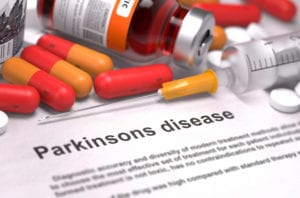Written by Joyce Smith, BS. Excessive antibiotic exposure is associated with an increased risk of Parkinson’s disease.
 While the cause of Parkinson’s disease (PD) remains unknown, environmental and genetic factors may play an active role in its pathogenesis. Known risk factors for the disease are pesticide exposure and rural living, while smoking and coffee drinking are protective 1. PD pathophysiology is characterized by mitochondrial dysfunction, oxidative stress, protein aggregation, and neuroinflammation 2. Alterations in gut microbiota have been found in people with PD. A healthy gut microbiome is necessary in order to preserve the structural integrity of a tight mucosal barrier junction and to regulate the microglia (immune system) 3. Excessive antibiotic exposure has been shown to alter the composition and diversity of the gut microbiome which in turn is associated with an increased risk of several psychiatric disorders 4, Crohn’s disease 5 and colorectal cancer 6. Several gastrointestinal disorders such as constipation 7, irritable bowel syndrome (IBS) 8, and inflammatory bowel disease 9 may increase PD risk.
While the cause of Parkinson’s disease (PD) remains unknown, environmental and genetic factors may play an active role in its pathogenesis. Known risk factors for the disease are pesticide exposure and rural living, while smoking and coffee drinking are protective 1. PD pathophysiology is characterized by mitochondrial dysfunction, oxidative stress, protein aggregation, and neuroinflammation 2. Alterations in gut microbiota have been found in people with PD. A healthy gut microbiome is necessary in order to preserve the structural integrity of a tight mucosal barrier junction and to regulate the microglia (immune system) 3. Excessive antibiotic exposure has been shown to alter the composition and diversity of the gut microbiome which in turn is associated with an increased risk of several psychiatric disorders 4, Crohn’s disease 5 and colorectal cancer 6. Several gastrointestinal disorders such as constipation 7, irritable bowel syndrome (IBS) 8, and inflammatory bowel disease 9 may increase PD risk.
Researchers from Helsinki University in Finland conducted a nationwide case-control study 10 to determine whether higher antibiotic exposure is associated with an increased risk of PD. The study compared data of antibiotic exposure in 13,976 people diagnosed with PD in Finland between 1998 and 2014, with 40,697 paired controls of similar geographical areas who were PD free.
Antibiotic exposure was based on data of oral antibiotics purchases from national registries and was analyzed in three different time-points: one to five years, five to 10 years, and 10 to15 years before PD onset. In their analyses, investigators also looked at antibiotic exposure after grouping medications in different categories (e.g. by chemical structure, antimicrobial spectrum, and mechanism of action).
During follow-up, 84.9% of PD patients and 83.6% of controls had purchased at least one antibacterial course (P<0.001). Penicillins were most popular, comprising 22.8% of all purchases, betalactams (22.3%) tetracyclines (18.6%). Only 16.4% of PD cases and 14.7% of controls had purchased at least one antifungal course (P<0.001). People with PD purchased more antibiotic courses than controls (6.32 versus 6.25; P=0.021), but the controls were hospitalized more frequently with bacterial infections (0.19 versus 0.16; P=0.017).Associations between antibiotic exposure and PD risk were stronger for anti-aerobic antibioticas than for non-anti-aerobics. PD risk was also associated with broad-spectrum antibiotics.
Study results suggest that prior exposure in particular to anti-anerobic as well as broad-spectrum antibiotics is associated with subsequent PD with a delay of 10 to 15 years between antibiotic exposure and the appearance of motor symptoms of PD. A similar association was found for antifungal medication with a delay of 1 to 10 years. Although no conclusions regarding causality can be made, the research team suggests that oral antibiotic exposure might be one factor that makes the gastrointestinal tract more susceptible to PD pathology, thereby increasing the risk of PD. Further studies are needed to validate these results.
Source: Mertsalmi, Tuomas H., Eero Pekkonen, and Filip Scheperjans. “Antibiotic exposure and risk of Parkinson’s disease in Finland: A nationwide case‐control study.” Movement Disorders (2019).
© 2019 International Parkinson and Movement Disorder Society
Click here to read the full text study.
Posted December 16, 2019.
Joyce Smith, BS, is a degreed laboratory technologist. She received her bachelor of arts with a major in Chemistry and a minor in Biology from the University of Saskatchewan and her internship through the University of Saskatchewan College of Medicine and the Royal University Hospital in Saskatoon, Saskatchewan. She currently resides in Bloomingdale, IL.
References:
- Noyce AJ, Bestwick JP, Silveira‐Moriyama L, et al. Meta‐analysis of early nonmotor features and risk factors for Parkinson disease. Annals of neurology. 2012;72(6):893-901.
- Rocha EM, De Miranda B, Sanders LH. Alpha-synuclein: pathology, mitochondrial dysfunction and neuroinflammation in Parkinson’s disease. Neurobiology of disease. 2018;109:249-257.
- Jandhyala SM, Talukdar R, Subramanyam C, Vuyyuru H, Sasikala M, Reddy DN. Role of the normal gut microbiota. World journal of gastroenterology: WJG. 2015;21(29):8787.
- Lurie I, Yang Y-X, Haynes K, Mamtani R, Boursi B. Antibiotic exposure and the risk for depression, anxiety, or psychosis: a nested case-control study. The Journal of clinical psychiatry. 2015;76(11):1522-1528.
- Virta L, Auvinen A, Helenius H, Huovinen P, Kolho K-L. Association of repeated exposure to antibiotics with the development of pediatric Crohn’s disease—a nationwide, register-based Finnish case-control study. American journal of epidemiology. 2012;175(8):775-784.
- Boursi B, Haynes K, Mamtani R, Yang YX. Impact of antibiotic exposure on the risk of colorectal cancer. Pharmacoepidemiology and drug safety. 2015;24(5):534-542.
- Adams-Carr KL, Bestwick JP, Shribman S, Lees A, Schrag A, Noyce AJ. Constipation preceding Parkinson’s disease: a systematic review and meta-analysis. J Neurol Neurosurg Psychiatry. 2016;87(7):710-716.
- Lai S-W, Liao K-F, Lin C-L, Sung F-C. Irritable bowel syndrome correlates with increased risk of Parkinson’s disease in Taiwan. European journal of epidemiology. 2014;29(1):57-62.
- Weimers P, Halfvarson J, Sachs MC, et al. Inflammatory bowel disease and Parkinson’s disease: a nationwide Swedish cohort study. Inflammatory bowel diseases. 2018;25(1):111-123.
- Mertsalmi TH, Pekkonen E, Scheperjans F. Antibiotic exposure and risk of Parkinson’s disease in finland: A nationwide case‐control study. Movement Disorders. 2019.
